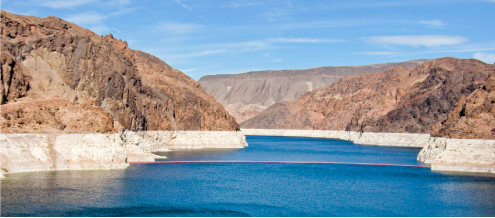By David Schaller
By the time this issue of Green Living magazine reaches you, the water level in Lake Mead will be in uncharted territory. The lake, a crucial water resource for Arizona, is already at its lowest level since the iconic reservoir was first filled 78 years ago. Before the year is out, Lake Mead’s water level is projected to be very near the point where water managers must declare that a Colorado River shortage exists.
Such a declaration could come as early as this August or perhaps not until 2016, but experts continue to raise the odds that a formal shortage declaration is inevitable. What then? While we would wish otherwise, the pending shortage declaration and its implications for Arizona will dominate civic conversation over this next year and in the years to come. Green Living intends to be a part of that conversation, helping inform readers as to what they can do to better ready themselves for the realities of living with less water.
Fortunately, many businesses and communities across the state have seen the need to adopt smarter ways of using water for some time. The image of a salty bathtub ring crusting the sides of Lake Mead as it emptied over the past decade serves as writing on the wall for many. Arizona’s water managers are using every opportunity, as they must, to promote action sooner rather than later to prepare for less Colorado River water coming our way. The fact that Arizona stands to take the biggest hit as regional shortages kick in makes every moment a teaching moment going forward. Without a modern precedent to guide us, we will have to learn on-the-job style as we lean into the water challenges ahead.
Statewide, the first to feel the pain will be low priority agricultural users and those urban areas currently recharging aquifers with their unused Central Arizona Project (CAP) allocations. Urban water users will likely duck the initial CAP shortfalls for at least a few years, but even this is not assured.
In the near term, water prices will rise for all CAP customers, even those who don’t share in the initial reductions in supply, as fewer users will have to bear the fixed costs of delivering system water to end users. Then, if not already, everyone in the state will have a compelling incentive to use water more efficiently, differently, or in cases such as letting some farmland go fallow, perhaps not at all.
Most likely the worst consequence of the pending water shortage would be a loss in confidence that we have the will and skill necessary to live with less water. If we doubt ourselves, we invite others to do the same. Our task is to show ourselves, our neighboring states, and indeed the country that we know how to be desert communities rather than communities that simply happen to be in the desert. In the months to come, Green Living
will feature the latest on Arizona communities, companies and organizations doing what they can and must to live with less water in an increasingly arid landscape.
We will track how our water footprint is linked to such themes as our use of energy, our production and consumption of food, the urban form, reimagining our desert landscape, water-smart business practices and more. The age of living with less water is upon us, and Green Living
will be there to help tell the stories.
David Schaller is a retired environmental scientist living in Tucson where he writes on climate, water and energy security.
Read more water articles at greenlivingaz.com/water







